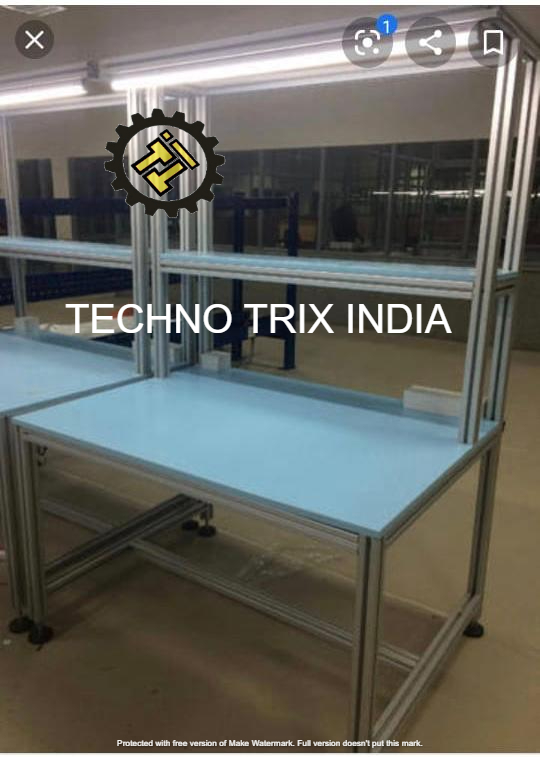ESD WORKSTATION n ESD (Electrostatic Discharge) workstation is a specially designed area or setup aimed at protecting sensitive electronic components and devices from electrostatic discharge damage. ESD occurs when static electricity is discharged, which can damage electronic components during handling or assembly. Below are the essential components and considerations for creating an effective ESD workstation: Key Components of an ESD Workstation: ESD Work Surface: An ESD mat or bench surface with conductive or dissipative properties, properly grounded. Designed to safely dissipate static charges. Grounding System: Common Ground Point: Ensures all components (mats, tools, personnel) are grounded to a single connection. Grounding cables connect mats and wrist straps to earth ground. Wrist Straps: Worn by operators to prevent static buildup. Must be connected to a ground point with a coiled or straight cord. Footwear and Floor Mats: ESD-safe shoes or heel straps for personnel, combined with ESD floor mats. Dissipates static from personnel when wrist straps are not practical. ESD-Safe Tools and Equipment: Tools made with dissipative materials, such as tweezers, screwdrivers, and pliers. ESD-safe packaging (e.g., shielding bags, conductive boxes) for handling components. ESD Monitoring Devices: Continuous monitors to verify grounding of personnel and surfaces in real-time. Testers for wrist straps, footwear, and mats. Ionizers: Neutralize static charges in the air for areas where grounding is insufficient or impractical (e.g., handling non-conductive materials). Design and Setup Considerations: Environmental Control: Maintain humidity levels (ideally 40–60%) to reduce static buildup. Use air purifiers or ionizers to control particulate contamination. Labeling and Signage: Clearly mark the ESD-protected area (EPA) with warning signs or floor markings. Label ESD-sensitive components to prevent mishandling. Personnel Training: Train staff on ESD safety, proper use of tools, and workstation procedures. Regularly remind operators of the importance of compliance. Regular Maintenance: Test all equipment (wrist straps, mats, grounding points) periodically to ensure proper functionality. Replace worn-out or damaged components promptly. Documentation and Compliance: Follow international ESD standards (e.g., ANSI/ESD S20.20 or IEC 61340-5-1). Keep records of ESD audits and equipment testing. Applications: ESD workstations are essential in industries such as: Electronics manufacturing and repair. Semiconductor fabrication. Aerospace and defense systems. Medical devices with microelectronics. If you'd like, I can guide you on setting up an ESD workstation or provide specific product recommendations. Let me know!
Chat with us on WhatsApp
×
This is your website preview.
Currently it only shows your basic business info. Start adding relevant business details such as description, images and products or services to gain your customers attention by using Boost 360 android app / iOS App / web portal.
ESD WORKSTATION n ESD (Electrostatic Discharge...

2024-12-27T17:05:49
ESD WORKSTATION n ESD (Electrostatic Discharge) workstation is a specially designed area or setup aimed at protecting sensitive electronic components and devices from electrostatic discharge damage. ESD occurs when static electricity is discharged, which can damage electronic components during handling or assembly. Below are the essential components and considerations for creating an effective ESD workstation: Key Components of an ESD Workstation: ESD Work Surface: An ESD mat or bench surface with conductive or dissipative properties, properly grounded. Designed to safely dissipate static charges. Grounding System: Common Ground Point: Ensures all components (mats, tools, personnel) are grounded to a single connection. Grounding cables connect mats and wrist straps to earth ground. Wrist Straps: Worn by operators to prevent static buildup. Must be connected to a ground point with a coiled or straight cord. Footwear and Floor Mats: ESD-safe shoes or heel straps for personnel, combined with ESD floor mats. Dissipates static from personnel when wrist straps are not practical. ESD-Safe Tools and Equipment: Tools made with dissipative materials, such as tweezers, screwdrivers, and pliers. ESD-safe packaging (e.g., shielding bags, conductive boxes) for handling components. ESD Monitoring Devices: Continuous monitors to verify grounding of personnel and surfaces in real-time. Testers for wrist straps, footwear, and mats. Ionizers: Neutralize static charges in the air for areas where grounding is insufficient or impractical (e.g., handling non-conductive materials). Design and Setup Considerations: Environmental Control: Maintain humidity levels (ideally 40–60%) to reduce static buildup. Use air purifiers or ionizers to control particulate contamination. Labeling and Signage: Clearly mark the ESD-protected area (EPA) with warning signs or floor markings. Label ESD-sensitive components to prevent mishandling. Personnel Training: Train staff on ESD safety, proper use of tools, and workstation procedures. Regularly remind operators of the importance of compliance. Regular Maintenance: Test all equipment (wrist straps, mats, grounding points) periodically to ensure proper functionality. Replace worn-out or damaged components promptly. Documentation and Compliance: Follow international ESD standards (e.g., ANSI/ESD S20.20 or IEC 61340-5-1). Keep records of ESD audits and equipment testing. Applications: ESD workstations are essential in industries such as: Electronics manufacturing and repair. Semiconductor fabrication. Aerospace and defense systems. Medical devices with microelectronics. If you'd like, I can guide you on setting up an ESD workstation or provide specific product recommendations. Let me know!
2024-12-27T17:05:49
Keywords
- iec 6134051
- personnel combined
- air purifiers
- verify grounding
- electronics manufacturing
- ansiesd s2020
- warning signs
- realtime testers
- tweezers screwdrivers
- dissipative materials
- ground point
- bench surface
- essential components
- setup aimed
- esd audits
- esd mat
- esd workstation
- heel straps
- wrist straps
- static electricity
- wrist straps footwear
- esd safety proper
- equipment tools made
- practical esdsafe tools
- damage electronic components
- reduce static buildup
- prevent static buildup
- esdprotected area epa
- pliers esdsafe packaging
- straight cord footwear
- specially designed area

Submit Your Enquiry